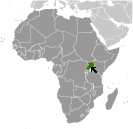World Atlas: Uganda. On this page you can see the map, country flag and many detailed information about the people, history and economy of Uganda.

Here you can find online selected information about the geography, inhabitants, government, economy and history of Uganda. Included are selected statistics, an overview map and the detailed map of Uganda. But let's start with the flag of Uganda here:
Uganda - Overview:
What you should know about Uganda? Let's start with this: The colonial boundaries created by Britain to delimit Uganda grouped together a wide range of ethnic groups with different political systems and cultures. These differences complicated the establishment of a working political community after independence was achieved in 1962. The dictatorial regime of Idi AMIN (1971-79) was responsible for the deaths of some 300,000 opponents; guerrilla war and human rights abuses under Milton Obote (1980-85) claimed at least another 100,000 lives. The rule of Yoweri Museveni since 1986 has brought relative stability and economic growth to Uganda. A constitutional referendum in 2005 cancelled a 19-year ban on multi-party politics. In December 2017, parliament approved the removal of presidential age limits.
Geography of Uganda
 Where on the globe is Uganda? The location of this country is East-Central Africa, west of Kenya, east of the Democratic Republic of the Congo. Total area of Uganda is 241,038 sq km, of which 197,100 sq km is land. So this is not a large country. How could we describe the terrain of the country? This way: mostly plateau with rim of mountains. The lowest point of Uganda is Albert Nile 614 m, the highest point Margherita Peak on Mount Stanley 5,110 m. And the climate is tropical; generally rainy with two dry seasons (December to February, June to August); semiarid in northeast.
Where on the globe is Uganda? The location of this country is East-Central Africa, west of Kenya, east of the Democratic Republic of the Congo. Total area of Uganda is 241,038 sq km, of which 197,100 sq km is land. So this is not a large country. How could we describe the terrain of the country? This way: mostly plateau with rim of mountains. The lowest point of Uganda is Albert Nile 614 m, the highest point Margherita Peak on Mount Stanley 5,110 m. And the climate is tropical; generally rainy with two dry seasons (December to February, June to August); semiarid in northeast.
Inhabitants of Uganda
Let's take a look how many people live in Uganda. The number is: 39,570,125. So quite a lot people live here. Who lives here? Baganda 16.5%, Banyankole 9.6%, Basoga 8.8%, Bakiga 7.1%, Iteso 7%, Langi 6.3%, Bagisu 4.9%, Acholi 4.4%, Lugbara 3.3%, other 32.1% (2014 est.). What are the languages in Uganda? English (official national language, taught in grade schools, used in courts of law and by most newspapers and some radio broadcasts), Ganda or Luganda (most widely used of the Niger-Congo languages, preferred for native language publications in the capital and may be taught in school), other Niger-Congo languages, Nilo-Saharan languages, Swahili, Arabic. And the religions: Protestant 45.1% (Anglican 32.0%, Pentecostal/Born Again/Evangelical 11.1%, Seventh Day Adventist 1.7%, Baptist .3%), Roman Catholic 39.3%, Muslim 13.7%, other 1.6%, none 0.2% (2014 est.). How old are the people in average? 15.8 years. We have to add that this number is the median - so one half of the people is older than this, one half is younger. And what is their life expectancy (at birth)? This: 55.9 years. Where the people live in Uganda? Here: population density is relatively high in comparison to other African nations; most of the population is concentrated in the central and southern parts of the country, particularly along the shores of Lake Victoria and Lake Albert; the northeast is least populated. The major urban areas of Uganda are: Kampala (capital) 1.936 million (2015).
Government and Economy of Uganda
The capital of Uganda is Kampala and the government type presidential republic. Let's take a look at the administrative divisions - 121 districts and 1 capital city; Abim, Adjumani, Agago, Alebtong, Amolatar, Amudat, Amuria, Amuru, Apac, Arua, Budaka, Bududa, Bugiri, Buhweju, Buikwe, Bukedea, Bukomansimbi, Bukwa, Bulambuli, Buliisa, Bundibugyo, Bunyangabu, Bushenyi, Busia, Butaleja, Butambala, Butebo, Buvuma, Buyende, Dokolo, Gomba, Gulu, Hoima, Ibanda, Iganga, Isingiro, Jinja, Kaabong, Kabale, Kabarole, Kaberamaido, Kagadi, Kakumiro, Kalangala, Kaliro, Kalungu, Kampala, Kamuli, Kamwenge, Kanungu, Kapchorwa, Kasese, Katakwi, Kayunga, Kibaale, Kiboga, Kibuku, Kiruhura, Kiryandongo, Kisoro, Kitgum, Koboko, Kole, Kotido, Kumi, Kween, Kyankwanzi, Kyegegwa, Kyenjojo, Kyotera, Lamwo, Lira, Luuka, Luwero, Lwengo, Lyantonde, Manafwa, Maracha, Masaka, Masindi, Mayuge, Mbale, Mbarara, Mitooma, Mityana, Moroto, Moyo, Mpigi, Mubende, Mukono, Nakapiripirit, Nakaseke, Nakasongola, Namayingo, Namisindwa, Namutumba, Napak, Nebbi, Ngora, Ntoroko, Ntungamo, Nwoya, Omoro, Otuke, Oyam, Pader, Pakwach, Pallisa, Rakai, Rubanda, Rubirizi, Rukiga, Rukungiri, Sembabule, Serere, Sheema, Sironko, Soroti, Tororo, Wakiso, Yumbe, Zombo. Regarding the economy of Uganda, important industrial products are sugar processing, brewing, tobacco, cotton textiles; cement, steel production. Important agricultural products are coffee, tea, cotton, tobacco, cassava (manioc, tapioca), potatoes, corn, millet, pulses, cut flowers; beef, goat meat, milk, poultry, and fish. The most important export commodities are coffee, fish and fish products, tea, cotton, flowers, horticultural products; gold and the most important export partners are Kenya 20.9%, UAE 11.2%, Rwanda 9.5%, Democratic Republic of the Congo 8.9%, Italy 4.5% (2016). The most important import commodities are capital equipment, vehicles, petroleum, medical supplies; cereals and the most important import partners are China 17.9%, India 17.2%, UAE 9.5%, Kenya 9.2%, Japan 5.2%, South Africa 4.5%, Saudi Arabia 4.4% (2016). How rich is Uganda and how rich are people in this country? The most important number here is GDP per capita (PPP): $2,400 (2017 est.). This is a very low number. Let's add that this means Gross Domestic Product per person, which is recalculated with respect to the relative cost of local goods and services. And one more important number - population below poverty line: 19.7% (2013 est.).